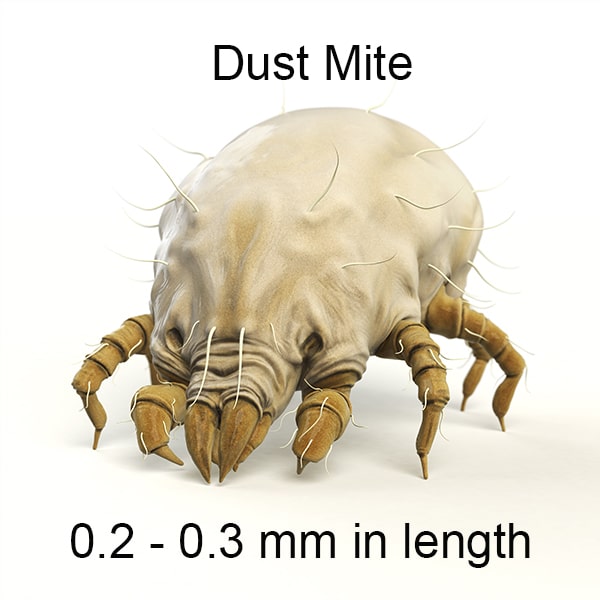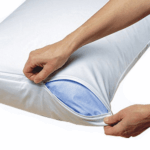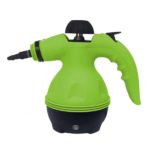
In the article
Dust mites are annoying little creatures that inhabit mattresses, couches, curtains, carpets, and upholstered furniture.
They are not only irritating but can also cause serious health concerns.
In this article, we will learn about dust mite allergy, its causes and symptoms, and how to treat and prevent this condition.
Can Dust Mites Cause Allergy?
If you think that allergies only come from food or airborne particles, here’s an interesting fact. House Dust mites can also cause allergy—and it’s not unusual. According to the National Library of Medicine, 20 million Americans experience dust mite allergy and about 30 per cent of the general population was recorded to be sensitive to house dust mites when a skin test reactivity was done.
While some people believe that it’s the dust mite’s bite that causes an allergic reaction in humans, it’s actually their waste and dead bodies that trigger the condition. Dust mites have proteins in their body and feces, which act as an allergen that creates an abnormal response to an individual’s immune system. Furthermore, if you are already suffering from asthma or other forms of allergies, contact with these tiny creatures can make them worse for you.

Dust Mite
Dust Mite Allergy: Understanding Common Causes
A dust mite allergy is a condition where the body negatively responds to proteins of dust mites because it sees them as an allergen or a harmful “invader”, similar to viruses and bacteria. When this happens, the body reacts and finds a way to get them out of the body.
What causes dust mite allergy? Firstly, it is important to understand that allergies happen when an individual’s immune system reacts to a substance, known as an allergen, that’s recognised by the body as harmful. In this case, if you have a dust mite allergy, the common causes are as follows:
Allergic to dust mite proteins found in their waste and dead bodies;
You are exposed to a significant volume of dust and dust mites;
Family or genetic history of other allergies; or
You have a weak or underdeveloped immune system.
Identifying the underlying cause of your allergy issue is crucial to know how you will treat the condition and prevent it from coming back.
Symptoms of Dust Mite Allergy
The common symptoms of dust mite allergy include the following:
Coughing
Congestion
Runny nose
Watery or itchy eyes
Sneezing
Itchy mouth, nose, or throat
Red, itchy skin
Wheezing and difficulty in breathing
Tightening of the chest
Because the symptoms of dust mite allergy are very similar to those of other forms of allergies, as well as flu and upper respiratory viral illnesses, it may be confusing to detect it accurately. If you’re not sure, seek out the help of healthcare professionals. Often, an allergy doctor (or allergist) will recommend that you take an allergy test to properly identify the real triggers of your allergy.
Can You Feel Dust Mites Crawlling On You?
Dust Mite Allergy Treatments
Despite the challenges, the good news is that dust mite allergy is treatable. If you are suffering from this type of allergy, below are some measures you can take to alleviate the symptoms and improve your overall health condition.
-
Take over-the-counter medications.
OTC or prescription medicines, such as decongestants and antihistamines, can help relieve symptoms like sneezing, coughing, watery eyes, and nasal congestion. Meanwhile, nasal corticosteroid sprays can reduce inflammation and alleviate nasal symptoms.
-
Consider immunotherapy or allergy shots.
If your case is severe, your allergist may recommend immunotherapy. In this procedure, you will be receiving a series of injections or allergy shots that gradually desensitise the immune system to dust mite allergens. It’s like teaching your body to tolerate and accept the allergen. Immunotherapy treatment typically requires 3 to 5 years of commitment, with symptoms starting to improve in the first 6 to 12 months.
-
Perform at-home dust mite treatment.
To reduce your exposure to dust mites, plan out a thorough at-home dust mite treatment using safe and organic products. Hiring a professional pest control company can be expensive; not to mention, they use strong chemical products that can be harmful to your health. So choosing a DIY route is a better option.
-
Conduct home remedies that will eliminate dust mites in your house.
There are several things you can do to reduce your exposure to dust mites and eradicate them from your home. These include:
Using allergen-proof mattresses and pillow covers to prevent dust mites from accumulating in your bedding.
Washing mattress covers, bed sheets, and pillowcases in hot water at least once a week to kill dust mites.
Using air purifiers with HEPA filters to reduce airborne allergens, including dust mite particles.
Using a vacuum cleaner with a HEPA filter to regularly clean carpets, upholstery, and curtains.
Maintaining a cool, dry environment, and using dehumidifiers if necessary.
Minimising clutter in the bedroom and throughout the house to reduce hiding places of dust mites.
As with other types of allergies, remember that treating dust mite allergy typically requires a combination of different steps in order to achieve the desired results. Furthermore, it is always best to consult with a professional physician.
Dust Mite Prevention Tips
As they say, prevention is always better than cure. If you are not yet experiencing dust mite problems at home, taking proactive measures will keep you from future concerns. Below are practical tips on how to prevent dust mites from penetrating your home:
- Use an allergen-proof mattress, pillowcases, and dust mite mattress encasement covers.
- Wash bedding, including sheets and pillowcases, in hot water weekly.
- If you start noticing their presence, use a dust mite steamer to get rid of them.
- Control temperature and humidity to discourage dust mite growth. Consider using dehumidifiers in damp areas.
- Use air purifiers with HEPA filters to reduce airborne allergens.
- Vacuum regularly with a HEPA filter-equipped vacuum cleaner.
- Minimise clutter in the bedroom and house. Throw or give away unused clothing, toys, books, and other clutter.
- Opt for washable curtains and blinds.
- Keep pets out of bedrooms to limit additional allergens.
Finally, consult with an allergist to get personalised advice and recommendations.
Treating a Dust Mite Allergy
Dust mite allergy may seem harmless to some people, but it can also bring serious health effects, especially in children. By educating yourself and your loved ones about the causes, symptoms, and treatment options of dust mite allergy, you can deal with this condition with confidence and improve your overall health and well-being.
For safe and natural dust mite products, Bed Bug Barrier carries an extensive array of tools you can use to prevent dust mite infestations at home. Our products are formulated with organic ingredients, which means you and your family are safe from harmful chemicals and poisons.







Leave a Reply